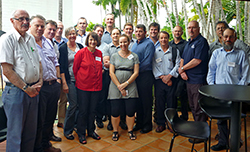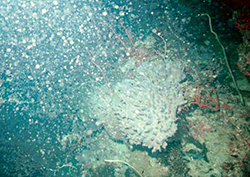25 March 2015
Facilitating informed decision-making is at the heart of AIMS participation in the development of a synthesis statement outlining the current state-of-knowledge of dredging and sediment disposal in the Great Barrier Reef.
AIMS’ senior scientists Drs Ross Jones, Richard Brinkman and Britta Schaffelke were part of an expert panel reviewing existing literature and supporting the development of key findings. The panel process was a joint initiative between the Australian Institute of Marine Science and the Great Barrier Reef Marine Park Authority.
Initiated in May 2014 with a three-day workshop, the project aimed to:
- Examine the potential physical, chemical and ecological changes associated with dredging and sediment disposal in the Great Barrier Reef Region;
- Identify knowledge gaps and opportunities for future research;
- Strengthen future monitoring programs; and
- Inform policy and best practice guidelines for future coastal development that includes dredging activities.
Project outcomes also inform emerging legislation to ban the disposal of dredge spoil material in the Marine Park from major capital projects.
The findings, summarised below, are captured in the report Synthesis of biophysical impacts from dredging and disposal in the Great Barrier Reef scheduled for release on 25 March 2015.
Brief Overview of Key Points
- Removal of sediment by excavation during dredging operations. Localised impacts are most significant. Regional ecological significance is small and known risks to macro fauna can be managed.
- Burial at marine dredge material disposal and reclamation sites. Localised impacts are most significant. Regional ecological significance is negligible.
- Changes to bathymetry and hydrodynamics by excavations. Localised, sufficiently predictable changes.
- Increased artificial lighting (at night) and underwater noise. Impacts are unclear, as it is difficult to isolate impacts of dredging from other coastal development activities.
- Release of fine sediment. There is a high level of uncertainty around the extent of impacts from plumes of suspended sediment to water column and marine organisms resulting from dredging and marine disposal.
- Potential contributions to chronic suspended sediments. Debate exists as to the extent to which sediments from dredge plumes are resuspended and transported throughout the Great Barrier Reef Region. There are multiple sources of suspended sediment including dredging spoil and natural inputs from rivers. With this in mind, the following insights are provided:
- Dredging is potentially a significant source of sediments; fine sediments are of most ecological concern.
- Despite known sensitivity, the exposure of coral reefs in the GBR to dredging pressures is generally low to medium, as dredging activities generally are not undertaken close to coral reefs.
- Suspended sediments, from multiple sources, may have serious impacts on recovery of reefs from other disturbances (reef resilience), although knowledge gaps remain.
- Seagrass meadows near dredging activities have a high exposure and sensitivity to dredging pressures, although some also have high capacity for recovery. But even small losses are of concern in the GBR.
- Disposal of dredge material on land or in reclamation. A range of impacts and challenges were identified, ranging from technical feasibility to the assessment of environmental impacts.
An electronic version of the complete synthesis statement is now available on the Great Barrier Reef Marine Park Authority web site.



